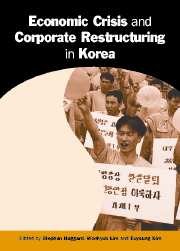Book contents
- Frontmatter
- Contents
- List of Figures
- List of Tables
- Preface and Acknowledgements
- Contributors
- A Note on Usage
- Abbreviations
- 1 Introduction: The Political Economy of Corporate Restructuring
- Part I The Politics and Economics of the Chaebol Problem
- 2 The Emergence of the Chaebol and the Origins of the Chaebol Problem
- 3 The Politics of Chaebol Reform, 1980–1997
- 4 The Government, the Chaebol and Financial Institutions before the Economic Crisis
- 5 Corporate Governance and Performance in the 1990s
- Part II The Political Economy of Crisis Management
- Part III Reform and Restructuring
- Index
4 - The Government, the Chaebol and Financial Institutions before the Economic Crisis
Published online by Cambridge University Press: 05 July 2014
- Frontmatter
- Contents
- List of Figures
- List of Tables
- Preface and Acknowledgements
- Contributors
- A Note on Usage
- Abbreviations
- 1 Introduction: The Political Economy of Corporate Restructuring
- Part I The Politics and Economics of the Chaebol Problem
- 2 The Emergence of the Chaebol and the Origins of the Chaebol Problem
- 3 The Politics of Chaebol Reform, 1980–1997
- 4 The Government, the Chaebol and Financial Institutions before the Economic Crisis
- 5 Corporate Governance and Performance in the 1990s
- Part II The Political Economy of Crisis Management
- Part III Reform and Restructuring
- Index
Summary
To address the fundamental causes of the Korean financial crisis, it is essential to understand the nature of the relationship among the government, financial institutions, and chaebol. This relationship has critically affected the overall efficiency and performance of the economy. While there have been numerous studies on the role of state-controlled finance in the development era, the evolution of the credit allocation mechanism throughout the recent period of financial liberalization remains poorly understood. This chapter focuses on the financing mechanism of the investment boom of this pre-crisis period and finds that the corporate financing pattern in the 1990s is characterized by two notable features: the rising volume of credit intermediated by non-bank financial institutions (NBFIs); and the increasingly shorter maturity structure of corporate debt, both domestic and foreign. Those features were in fact deeply connected with the nature of financial liberalization policies undertaken, and they reflected distorted incentives rooted in a legacy of implicit government guarantees.
Conventional wisdom emphasizes the role of commercial banks and their relationship with the government as a main culprit in the crisis. This chapter argues that distorted credit allocation channeled through the liberalized sector – NBFIs and direct financing – contributed to the vulnerability of the financial system. Hence, the root cause of the crisis can be traced to the mismanagement of the transition process to a truly operating market economy.
- Type
- Chapter
- Information
- Economic Crisis and Corporate Restructuring in KoreaReforming the Chaebol, pp. 79 - 101Publisher: Cambridge University PressPrint publication year: 2003
- 12
- Cited by



